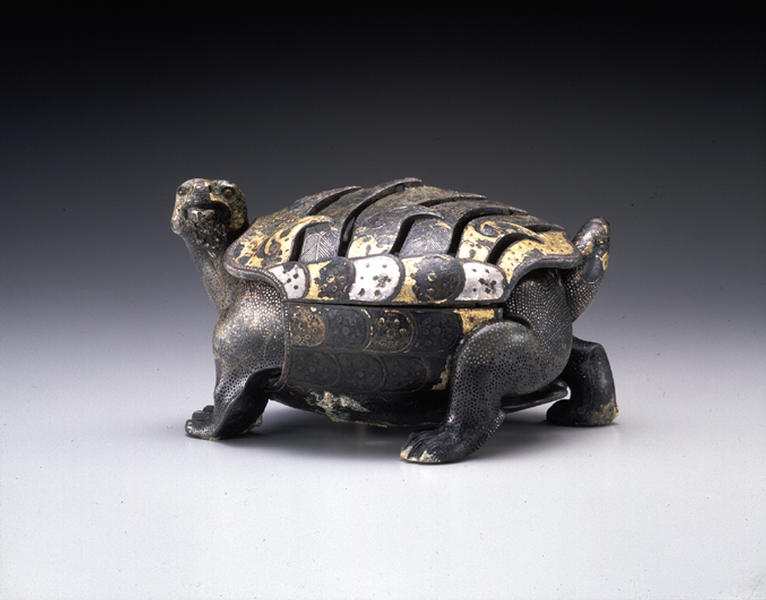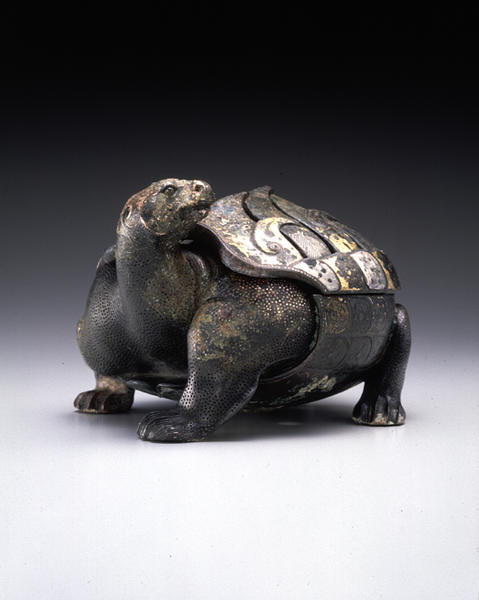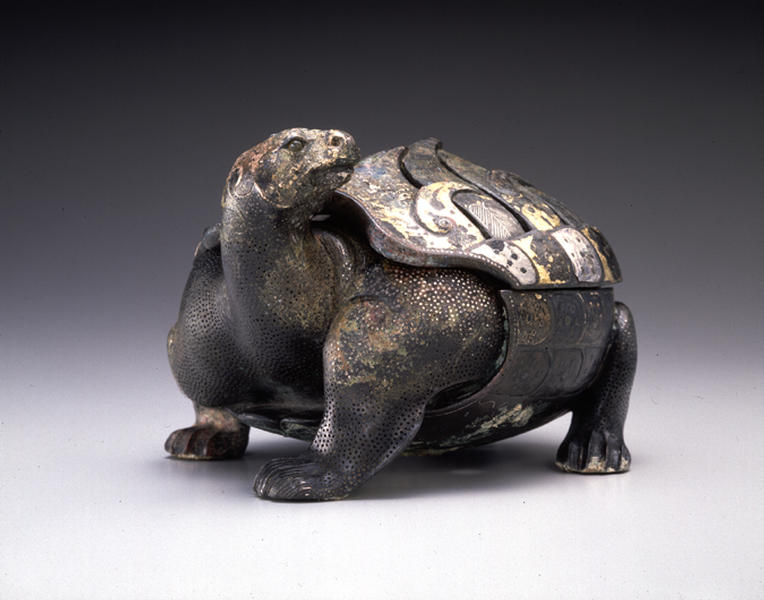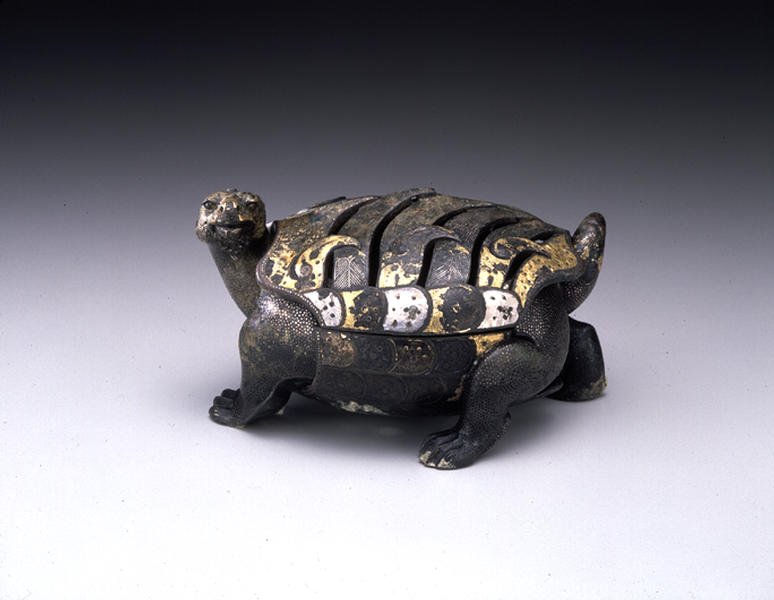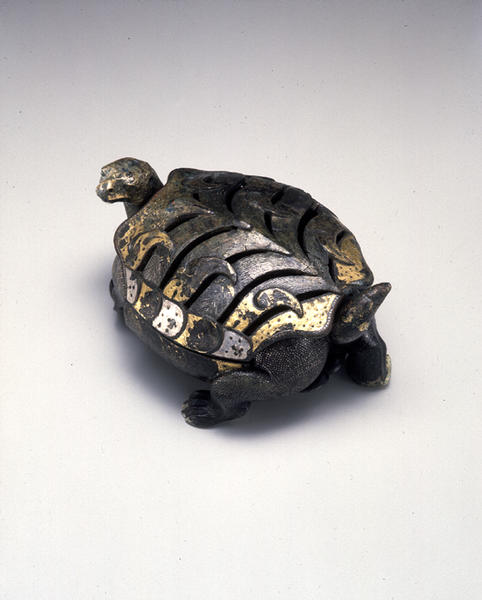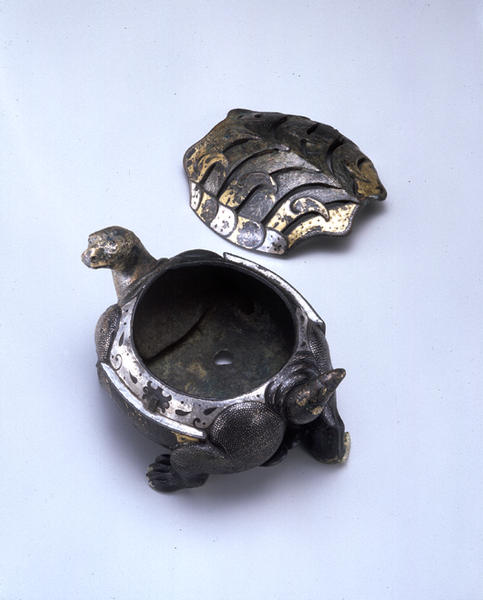亀形香炉
- 中国・漢時代
- 3cB.C.-3A.D.
- 青銅、金、銀
- D-11
解説(開館1周年記念展)
この青銅製の亀は,右脚を後ろに引き左脚を前に出してゆっくりと歩む体勢でしばし止まり,首をもたげ左を振り向く。尻尾は右上に向けられている。透彫を施した甲羅は蓋として取り外せるようになっており,甲盛りの中央頂部側面に孔が穿たれているが,これは蓋の重心にあたり,鈕が取り付けられていたと想像される。更に頭頂部に環の破損痕と思われる部分が見られることから,おそらく頭部と蓋を鎖のようなものでつないでいたのであろう。蓋内側面と器にあたる身の口縁側面はほぞによって組み合わさるようになっている。身底には不定形の通気孔が3か所空けられている。
力強く造り出された鋭い爪をもった四肢と頑丈そうな首に銀の粒文を施して,は虫類の表皮を表し,現実味のある顔面と尻尾には金を被せ,目には透明な褐色がかった丸い石が嵌め込まれている。更に下の甲羅には銀象嵌の波線で縫合が表現され,頭の先から尾の先端まで力のみなぎったこの堂々たる体躯の表現は,小さいながら神亀の畏こさを想わせる。
蓋の合わせ目には,蓋側面に1列,身の側面に2列,七曜文風の粒文を施した鱗意匠が見られる。甲羅の表現は通常には見られないもので,銀線の象嵌で中央が尖った線条の流れを作り,両脇に金象嵌の,渦を含んだ鳥の嘴状の尖端をもった形が付けられている。甲羅の前と後の部分にも粒文を含む金象嵌が施されている。この甲羅の透彫の意匠は湖北省江陵県望山1号墓や随県曽侯乙墓の戦国時代の香草を入れた器ないし香炉に見られる怪異な鳥形や龍形を含む雲気の透彫に通じるものがある。*1
漢代の香炉は,蓋部に仙山をかたどった博山炉が一般的であるが,しばしば支柱を亀や鳳凰でかたどった。ここに見られるような獣形香炉の類は比較的類例が少ないが,山西省朔県,河南省南陽市や湖北省沙市出土のものが知られている。*2 特にこのような1頭の動物を生き生きと造り出した例は希少で,単なる日常の道具を超えている。
亀は古来吉凶を知る神聖な存在とされ,名亀を得ることによって家が繁栄すると信じられた。中でも神の使いとしての亀,神亀について,「大きさは拳の如く,色は金の如く,甲羅の両側は鋸歯の如く,爪は至って鋭利」という心象が古くから存在し,亀は千年で毛が生え,五千年で神亀となるとも言われている。*3 おそらくこれらの複合した心象がこの黄金に輝く亀形の香炉に込められ,かなり現実味のある表現で造り出されたことが想像される。
1 「湖北省博物館」東京1989年;ed. Thomas Lawton/New Perspectives on Chu Culture During the Eastern Zhou Period/Washington D.C. 1991
2 文物1987年第6期;考古1966年第2期;文物1965年第11期
3 本草・水亀;述異記;ref. 諸橋轍次/大漢和辞典/東京1960
Catalogue Entry
This bronze tortoise appears to stop for a moment, taking a break from a slow walk, with the right legs pulled back and the left legs pushed forward, and with the head lifted up to the left. The tail is directed to the upper right. The openworked shell is removable, like a lid, and a hole is made at a side of the center ridge, where the center of gravity of the lid is presumed to be, perhaps to allow a string to be attached through it. There appear to be traces of damage caused by a chain link at the top of its head, suggesting that the head and the lid might have been chained together. The inside of the lid and the body of the tortoise, which the lid covers, fit snugly by means of a tongue and groove joint. The bottom is provided with three irregularly shaped ventilating holes.
Tiny silver dots are inlaid on the surface of the four legs, which have strong claws, and on the stout neck to mimic reptile skin; the realistic face and the tail are covered with gold, and translucent, brownish, round stones are placed in the eye holes. In the under shell, the grooves are shown by wavy lines of silver inlay. Small as it is, the magnificent body filled with power from head to tail communicates the solemnness and awe of a sacred tortoise.
The area where the lid meets the rest of the figure is adorned with a decorative scale pattern and seven-eyes like motif one row on the lid and two rows on the body. The shell is strikingly unusual; it is represented by silver wire inlay, which makes a linear flow that appears sharp at the center. Either side of the shell is adorned with designs in gold inlay which resemble a curved bird's beak. Both the front and rear ends of the shell provide a grainy texture executed in gold inlay. This openwork shell design is reminiscent of the cloud spirit, manifested as fantastic bird and dragon designs, on herb vessels and censers dating back to the period of Warring States, such as those found in tombs in Wangshan Jianglingxian, and Zeng Hou Yi, Hubei Province.*1
In the Han period (206 B.C.-A.D. 220), censers were generally produced with a lid sculpted to resemble a sacred mountain, and, frequently, the support was carved with a design of a tortoise or a Chinese phoenix. Censers made in the shape of an animal are relatively rare, though examples are known from excavations in Shanxi, Henan, and Hubei Provinces.*2 The present figure is not only rare but remarkable in that an animal-shaped censer was made with such care and interest in realism, far surpassing the need dictated by utility for daily life.
From the time of antiquity, the tortoise has been regarded as a sacred animal that possesses knowledge about future outcomes or events, and it was believed that prosperity would bless a household if the family obtained a particularly auspicious specimen. A commonly-held image of a tortoise as a messenger from a deity called for a tortoise that was fist-sized, gold in color, with the edges of both sides of the shell serrated like saw teeth and claws that were extremely sharp. It was also said that hair begins to grow on a tortoise after it is 1000 years old and, when it is 5000 years old, it was to be regarded as sacred.*3 It may not be too far off the mark to say that the artist summoned an aggregation of such images about the tortoise when creating this rather realistic golden censer in a tortoise shape.
